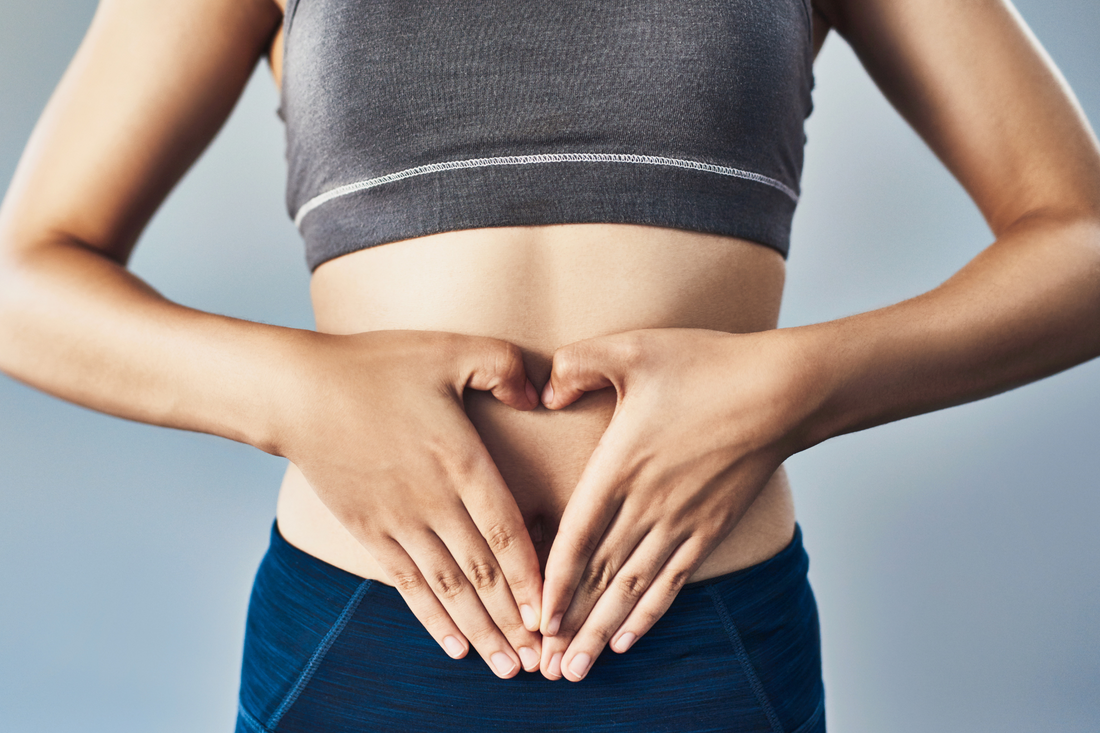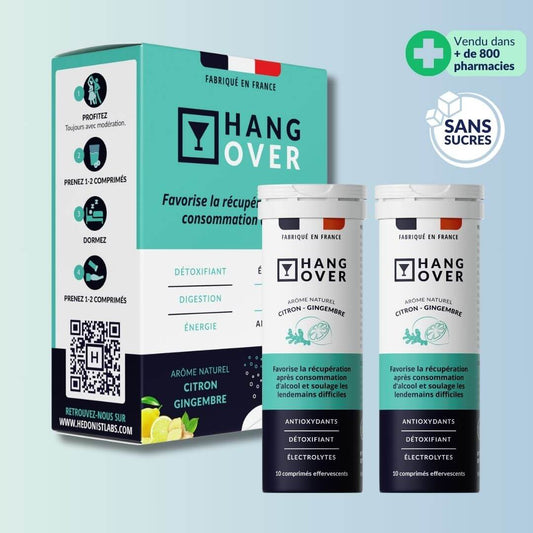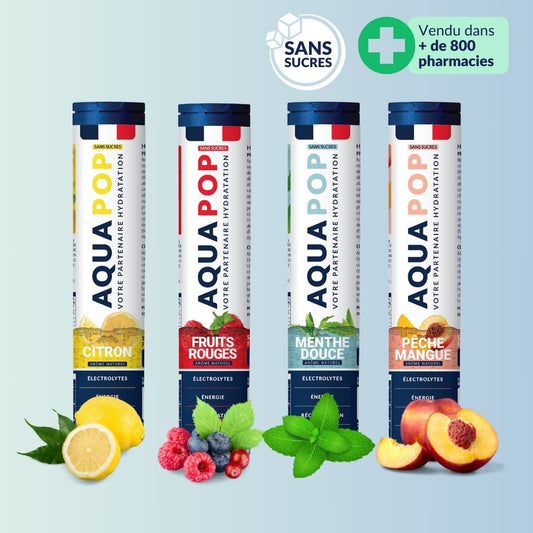HANG-OVER supports the alcohol metabolism process thanks to three elements: NAC, Vitamin E and grape-seed extract. In this article, we'll take a closer look at how each ingredient works.
NAC (N-Acetyl-L-cysteine)
L'acetaldehydea toxic metabolite of ethanol, harmful to our bodies and particularly harmful to the liver, is formed during the alcohol elimination process.
To eliminate acetaldehyde, the body uses two elements: aldehyde dehydrogenase and acetaldehyde dehydrogenase.aldehyde dehydrogenase and glutathione. This metabolic cascade is efficient, but quickly saturated due to a lack of glutathione, leading to numerous undesirable effects.
Fortunately, there is a way to counteract this problem by properly supplementing the body with NAC.[1]
The body's most powerful antioxidant is Glutathione. [2]
Most foods will contain it, but it is difficult for our digestive system to absorb, and breaks down before entering the body. It plays an important role in the liver's detoxification process and in the functioning of the immune system.
It also helps the body to rid itself of toxins present in food and the environment. Glutathione is formed fromglutamic acidacid cysteine and glycine.
Of these three elements, the one that the body lacks is L-cysteine. N-acetyl-l-cysteine (NAC) is a precursor of L-cysteine. Supplementing the body with NAC provides the body with a supply of L-cysteinewhich promotes glutathione biosynthesisin other words, to replenish its reserves[...3]
Raising glutathione levels promotes the detoxification process, since it acts directly as an antioxidant by scavenging free radicals. NAC has therefore been identified as a therapeutic option in the management of certain pathologies characterized by the development of free radicals.[4]
The right amount of glutathione helps support the immune system and neutralize toxins.
NAC also helps prevent liver damage
Numerous studies have shown that NAC helps prevent liver damage during alcohol consumption[.5] The effectiveness of its hepatoprotective action has been demonstrated by clinical use in paracetamol intoxication: if administered correctly at the right time, hepatic damage is neutralized. This is known as the antidote to paracetamol poisoning[6]
The dosage used in these studies suggests that NAC should be taken before alcohol consumption for best results. Thus glutathione production will be active and able to meet metabolic needsand effectively eliminate ethanol's toxic metabolites.
Vitamin E
In the process of eliminating the alcohol, theAcetaldehydepresent in excessive quantities, releases free radicals (nitrogenous and oxygenated) which are toxic toxic to the body.
Visit Vitamin E is an antioxidant agent that must be supplied via our diet, as the body is unable to synthesize it. the body is unable to synthesize it. It helps protect polyunsaturated fatty acids (good fats) and other components of cell membranes (e.g. low-density lipoproteins) against oxidation by free radicals[7,8,9]
100 years of research have demonstrated that Vitamin E possesses numerous antioxidant properties, such as the scavenging of reactive oxygen and nitrogen species[.10] Vitamin E is the most abundant and powerful free radical scavenging antioxidant agent in vivo. [11]
Vitamin E is therefore essential for the elimination of free radicals from alcohol consumption.
Grape seed extracts
The oxidative stress is the loss of balance between the oxidative and anti-oxidative systems of cells and tissues, towards an overabundance of reactive oxygen species (ROS: free radicals, oxygen ions, peroxides)
Grape seed extract is rich in Oligo-proanthocyanidins (OPC).
The proanthocyanidins in grape seeds have been shown to act as free radical scavengers than vitamins C, E and β-carotene in vitro and in vivo[12,13]
The most widely recognized mechanism of action is the inhibition of lipid peroxidation, preventing the production of ROS and thus saving cell membranes from apoptosis (programmed destruction).
The researchers reported that grape-seed proanthocyanidin extracts re-balance cellular redox status via glutathione synthesis pathways[.14] Another study reported that grape-seed procyanidins had a protective effect against ethanol-induced toxicity in mouse brain cells[15]
This combination of antioxidants (vitamin E, OPC and NAC) is a judicious choice for the treatment of veisalgia or hangovers. With a focus on prevention and detoxificationIt helps to capture free radicals and combat the damage caused by oxidative stress. In addition, this combination stimulates glutathione biosynthesis, which helps the body eliminate toxins generated by excess alcohol.
[1] Morozova TV, Goldman D, Mackay TF, Anholt RR. The genetic basis of alcoholism: multiple phenotypes, many genes, complex networks. Genome Biol. 2012;13(2):239. Published 2012 Feb 20. doi:10.1186/gb-2012-13-2-239.
[2] Elgindy EA, El-Huseiny AM, Mostafa MI, Gaballah AM, Ahmed TA. N-acetyl cysteine: could it be an effective adjuvant therapy in ICSI cycles? A preliminary study. Reprod Biomed Online. 2010;20(6):789-796.
[3] Pieralisi A., Martini C., Soto D., Vila M.C., Calvo J.C., Guerra L.N. N-acetylcysteine inhibits lipid accumulation in mouse embryonic adipocytes. Redox Biol. 2016;9:39-44. doi: 10.1016/j.redox.2016.05.006.
[4] Shahin AY, Hassanin IM, Ismail AM, Kruessel JS, Hirchenhain J. Effect of oral N-acetyl cysteine on recurrent preterm labor following treatment for bacterial vaginosis. Int J Gynaecol Obstet. 2009;104(1):44-48.[23] Tunek A. Possible mechanisms behind the anti-inflammatory effects of N-acetyl cysteine; is metabolism essential? Eur Respir Rev. 1992; 2(7): 35-38.
[5] N-acetyl cysteine in the treatment of alcohol use disorder in patients with liver disease: Rationale for further research. Kirsten C. Morley, Andrew Baillie, Wim Van Den Brink, Kate E. Chitty, Kathleen Brady, Sudie E. Back, Devanshi Seth, Greg Sutherland, Lorenzo Leggio & Paul S. Haber. Pages 667-675 | Received 28 Mar 2018, Accepted 13 Jul 2018, Accepted author version posted online: 18 Jul 2018, Published online: 01 Aug 2018
[6] Acetaminophen Toxicity Treatment & Management, Updated: Jan 17, 2020 author heading Author: Susan E Farrell, MD; Chief Editor: Michael A Miller
[7] World Health Organization (WHO) Food and Agriculture Organization (FAO) Vitamin and Mineral Requirements in Human Nutrition: Report of a Joint FAO/WHO Expert Consultation, Bangkok, Thailand, 21-30 September 1998. WHO, FAO; Geneva, Switzerland: 2004.
[8] Sato K, Niki E, Shimasaki H. Free radical-mediated chain oxidation of low density lipoprotein and its synergistic inhibition by vitamin E and vitamin C. Arch Biochem Biophys. 1990.
[9] Bowry VW, Ingold KU, Stocker R. Vitamin E in human low-density lipoprotein: when and how this antioxidant becomes a pro-oxidant. Biochem J. 1992.
[10] Zingg J.-M. Vitamin E: An overview of major research directions. Mol. Asp. Med. 2007.
[11] Jasmeet Kaur 1, Sonia Shalini, M P Bansal. Influence of vitamin E on alcohol-induced changes in antioxidant defenses in mice liver. Toxicol Mech Methods.2010 Feb
[12] Rani V., Deep G., Singh R.K., Palle K., Yadav U.C. Oxidative stress and metabolic disorders: Pathogenesis and therapeutic strategies. Life Sci. 2016.
[13] Bagchi D., Swaroop A., Preuss H.G., Bagchi M. Free Radical Scavenging, Antioxidant and Cancer Chemoprevention by Grape Seed Proanthocyanidin: An Overview. Mutat. Res. Fundam. Mol. Mech. Mutagen. 2014.
[14] Grape seed procyanidins prevent oxidative injury by modulating the expression of antioxidant enzyme systems. Puiggros F, Llópiz N, Ardévol A, Bladé C, Arola L, Salvadó MJJ Agric Food Chem. 2005 Jul 27.
[15] Direct in vivo evidence of protective effects of grape seed procyanidin fractions and other antioxidants against ethanol-induced oxidative DNA damage in mouse brain cells. Guo L, Wang LH, Sun B, Yang JY, Zhao YQ, Dong YX, Spranger MI, Wu CF J Agric Food Chem. 2007 Jul 11.




